The Devil Rides Out (1968)
Directed by: Terence Fisher
Written by: Dennis Wheatley, Richard Matheson
Starring: Charles Gray, Christopher Lee, Leon Greene, Nike Arrighi
UK
AVAILBLE ON BLU-RAY AND DVD
RUNNING TIME: 95 mins
REVIEWED BY: Dr Lenera, Official HCF Critic
SPOILERS!
England 1929: the Duc de Richleau and Rex Van Ryn are concerned that their friend Simon has been behaving oddly. When they visit his house, they find that he’s hosting a meeting of a sect of Satanists led by the powerful Mocata. They take him back to the Duc’s house in a bid to free him of Mocata’s influence, but Simon escapes. While the Duc goes off to do some research, Rex finds another novice Tanith whom he’s taken a shine too, but she gets away too, her and Simon now both heading for a black mass in the woods where they will be baptised into evil….
A film which is many people’s favourite Hammer film [even Christopher Lee says this, though remember he said that he considered Taste Of Fear to be Hammer’s best movie], and probably mine too [it occasionally regresses to second or third place but never further back than that], The Devil Rides Out is basically a variant on Dracula if you think about it, though it also stands apart from the many Frankenstein, Mummy etc. films they kept making, even if it’s probably the ultimate statement of director Terence Fisher’s, and by hint Hammer’s, views of good and evil before they started to muddy the waters a bit more than before. Hammer never delved into stuff like black magic again, and nor did they ever make a film with such a fast pace to it [Dracula and Frankenstein Must Be Destroyed perhaps being the closest competitors in that respect]. The film is jam packed with incident and thrills, almost coming across as a scarier version of an old serial some of the time, yet it constantly maintains a feel of dread, an evil which can strike any place and anywhere. Perhaps paradoxically, it’s also rather quaint at times, and the special effects are variable and in some places unfinished, though they’re usually surrounded by so much quality of acting, staging, set design – you name it – that I’m happy to give most of them a pass. The only major flaws to the film to me are that the famous set-piece three quarters of the way through is so exciting that the last 20 minutes or so are just a tad anti-climactic, and that the dues ex machina ending has always struck me as a big cop out. But everything else is first class, and if you don’t consider it to be one of the studio’s best films, you must agree that it contains some of its best moments.
It was Lee who encouraged Hammer to buy the rights to three of Dennis Wheatley’s black magic novels: The Devil Rides Out, The Satanist and To The Devil….A Daughter, though oddly the rights to the first of these, written in 1935, were already owned by two others – Micheal Stainer-Hutchins and Peter Daw when Hammer got John Hunter to wrote a script in 1963, a script which both potential US distributor Universal and producer Anthony Hinds rejected [the latter calling it “too English”]. Hammer then held off on re-writes for a while because they were worried about the BBFC’s reaction. 1966 saw noted science fiction writer Richard Matheson pen a screenplay which stands as an object lesson in how to adapt a novel for the screen, trimming all the fat but changing very little of the plot and even keeping some dialogue. This time co-producers and distributors Seven Arts, 2oth Century Fox and ABPC were definitely interested. Stainer-Hutchins finally agreed to sell the rights to the book on the proviso that he do the special effects, though most sources claim that Hammer’s usual effects man Les Bowie did a great deal of the work. Gert Frobe [Goldfinger himself] turned down in the role of Mocata, while Leon Greene was dubbed by Patrick Allen, the real life husband of co-star Sarah Lawson. Shooting took place at Elstree and in and around Boreham Wood. The first cut was significantly tightened. Released as the main feature on a double bill with the shoddy Slave Girls, it did good business in the UK but failed to get much interest in the US despite being re-titled The Devil’s Bride so it didn’t sound so much like a Western! Wheatley, though, sent letters to both Matheson and Hammer’s office, praising the adaptation, a rare thing for an author to do.
I suppose I should digress slightly here to offer my views on the controversial restored version of The Devil Rides Out which came out on Blu-ray in 2012. Some of the effects moments received some digital tampering to improve them, notably the spider scene which now features a shadow and digital smoke when water is thrown onto it, and the Angel of Death appearance which now contains a light effect illuminating the door to cover the poor original optical effect when the angel rides through it, and flames behind the close up of the Angel as the original intended shot just showed a blue screen. Elsewhere lots of matte lines were tidied up. Considering that much of the effects work wasn’t finished due to time and money, these alterations hardly strike me as George Lucas-style revisionism with the possible exception of some CGI clouds near the beginning. The alterations don’t stick out and the film still looks like a low budget 1968 one, just one where some of the effects were completed. Frankly I applaud most of what they did here, though of course the Blu-ray ought to have included the original cut as well for the purists.
After perhaps Hammer’s most menacing title sequence, James Bernard’s dissonant theme and the credits ocurring over woodcarving-style pictures of the Devil and occult symbols, Matheson’s screenplay wastes no time whatsoever in getting into the action, the Duc and Rex finding their absent friend Simon hosting Satanists and quickly taking him away, though head of the sect Mocata straightaway demonstrates his power by making Simon’s crucifix nearly choke him to death unless it’s removed. The Duc and Rex follow him back to his house, and after some much tense creeping around, we get to a moment that’s a little uncomfortable when seen today, with the two menaced by a demon in the form of a grinning black man in a nappy, though I doubt any racism whatsoever was intended. Never mind, we soon get a cracking [despite the back projection] car chase with Rex pursuing the fleeing Tanith, though I can never help chuckling at the bit just before when Rex asks the Duc: “May I borrow a car”?, and the response is: “Yes, take any of them”. Matheson wisely removed Wheatley’s somewhat uncomfortable [at least to many modern readers] reactionary elements, but bravely kept the casual air of snobbery and the whole film has a great period feel. We soon get to a bit that gobsmacked me when I first saw it as a kid. Before the baptism of Tanith and Simon, the Satanists hold a rather silly looking orgy [the book had the participants nude], but then the Devil himself is conjured up, and there aren’t that many films, at least of a commercial nature, which actually show the character in such a literal manner. He’s just a guy with a goat mask, but there’s just something so frightening about the moment.
One hair-raising rescue after and we’re not far away from the incredible pentagram sequence where most of our ‘good’ characters are beset by demonic presences and tempters praying on scepticism, doubt, jealousy – you name it. Evil is truly insidious in this film, one reason why the film can still frighten the first time. Magnified spider notwithstanding, the moment where young Peggy Eaton, the daughter of the Duc’s friends Richard and Marie, has the arachnid rearing up before her, is amazingly intense, and the Angel Of Death is such a striking design [and again so conceptually stunning – this film really does tap into areas few films do so even now] that the possible awkwardness of the repeated shots and slow motion [and the knowledge that the horse being used was asthmatic and couldn’t actually do very much in one go] is mostly overcome. James Bernard’s incredible scoring also helps immensely –this film really is an object lesson in how a strong score can add to the effect of a film. However, to my mind the high point of the film, and possibly Fisher’s best ever piece of directing, is when Mocata visits the Eaton household and begins to place Marie under his hypnotic influence. After showing the two both sitting across from each other in a long shot, the individual shots of Marie become slightly longer while the shots of Mocata tend to be short, slightly jagged and closer up. As Marie becomes under Mocata’s spell, the camera then slowly tracks into her from a distance, the track interrupted by a few quick close-ups of Mocata’s face, and then we finally see them both together in close-up. It may not be technique of an especially showy kind, but it shows Fisher’s absolute mastery of cinema when he was totally focused on a project, though we should also praise editor Spencer Reeves and actor Charles Gray, the latter really able to make us think that Mocata has such power over minds. And then the scene finishes with one of the best lines in horror movie history, delivered just perfectly by Gray: “I won’t be back, but something will”.
And yet I cannot help but say that The Devil Rides Out weakens a little towards the end. What Mocata is actually trying to do isn’t entirely clear [in the book, he’s after something called the Talisman of Set which could give him world domination], and he and his lot are dispatched rather too easily and quickly. And then, because the Duc has uttered some words, we have some time reversal, and we’re back in the pentagram room again, and dead people are still alive, and everything’s wrapped up with no tragedy, and the Duc thanks God – it’s all just a bit much and far too convenient – and this is coming from someone who doesn’t tend to have a problem with religious stuff in films even if he isn’t religious himself. Of course one can’t criticise Matheson too much because he’s just following the book which ended in a similar manner, but I do believe that he should have risked annoying Wheatley and tried to improve on him here by leaving out at least some of this stuff. After all, good still beats evil if you remove the final couple of minutes, it’s just at more of a price. The film could also have done with an extra moment or two featuring Rex and Tanith who seem to fall in love absurdly easily, though one moment involving them, rather reminiscent of the staking scene in Dracula: Prince Of Darkness, could very well be the most upsetting image in the whole film – the bound and gagged Tanith writhing hysterically under Mocata’s influence and desperately trying to break free from her bonds while Rex watches and clearly wants to free her even though he knows that he shouldn’t.
Nike Arrighi, an unconventional beauty by Hammer’s standards, is totally beguiling and wonderfully enigmatic throughout, at her best when showing a numbed, wide eyed kind of look, like when she’s spattered with goat’s blood in a film which otherwise avoids the expected gore – and which certainly doesn’t require it. Fisher had to fight to have her in the film, the producers wanting the typical model look. Greene is a most likeable hero, and actually you wouldn’t know he’s dubbed unless you’d heard his real voice. But of course actor-wide the film belongs to Lee and Gray who are just marvelous antagonists. In Hammer’s world, the majority of humanity is either blissfully ignorant or terribly weak-willed while the true issues of good and evil are fought over between two equally charismatic individuals of sternly opposed will, and who almost come across as alter egos, with suggestions here that the Duc is as dangerous and mysterious as his opponent, an opponent though who clearly has more fun. Lee is razor sharp, cold and slightly frightening, someone you certainly want on your side [and it helps knowing that Lee himself was very knowledgeable about black magic] but also someone you don’t feel that you want to get to know too much. And Gray, playing a character based on Alistair Crowley, suggests so much depravity and pure evil by doing very little. Just look at the way he smugly surveys everyone during the orgy.
Bernard Robinson’s set design is tremendous throughout – watching the film and trying one’s best to pay attention to this kind of thing reveals elegant use of colour in so many of the sets, right from the main lounge of Simon’s house where the room is mostly green but has pink pillars to go with the pink of the carpet and Tanith’s dress. And then there’s Bernard’s pulsating score which is definitely one of his finest works, stretching his limited orchestra to its limit time and time again, giving us some wonderful cliff-hanging action scoring, returning in places to the truly dark, scraping sound of his Quatermass scores for some of the scariest moments, yet transforming his sinister title theme into a glorious anthem at the film’s close. Despite my issues with the final reel or two, there’s no doubt that pretty much everyone involved tried their very best on The Devil Rides Out, a film which is as fabulously exciting and menacing today as it must have been in 1968. Every now and again there’s talk about remaking it, Lee himself being enthusiastic at one point. And yes, the effects would be better – but that’s about it, and effects aren’t everything even though so many films made today give that impression. Leave it alone.

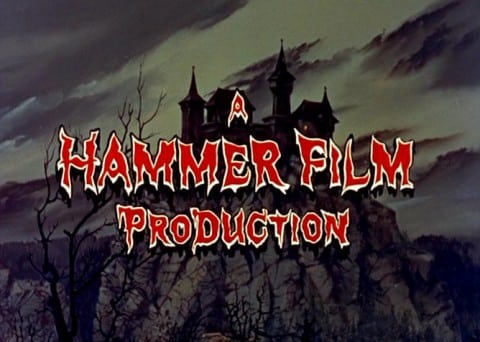
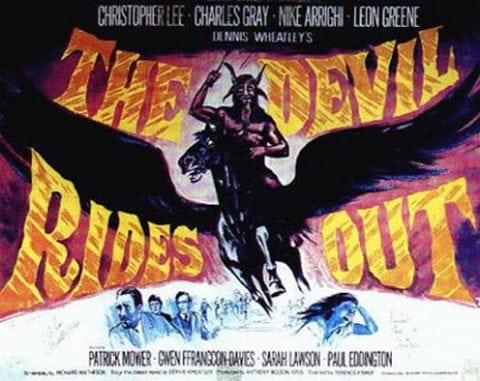


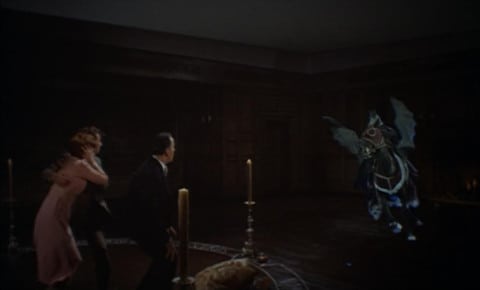



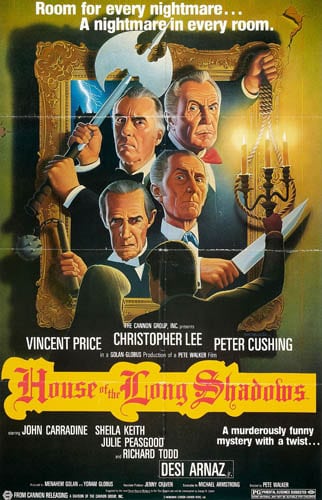

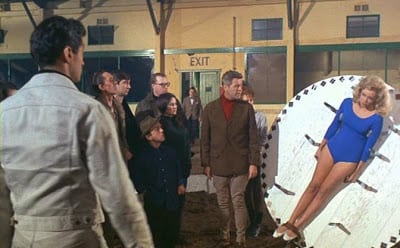
Be the first to comment